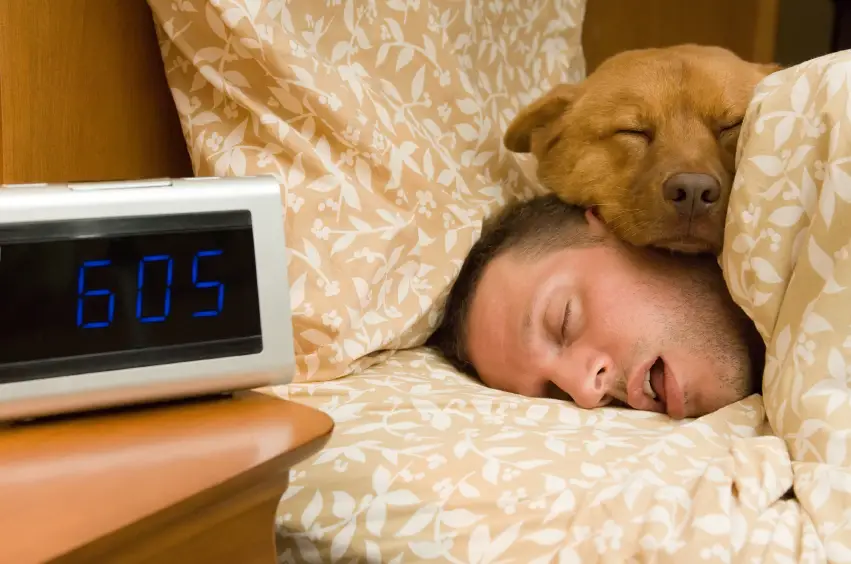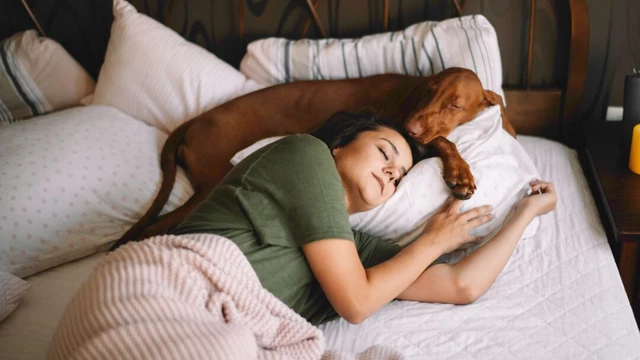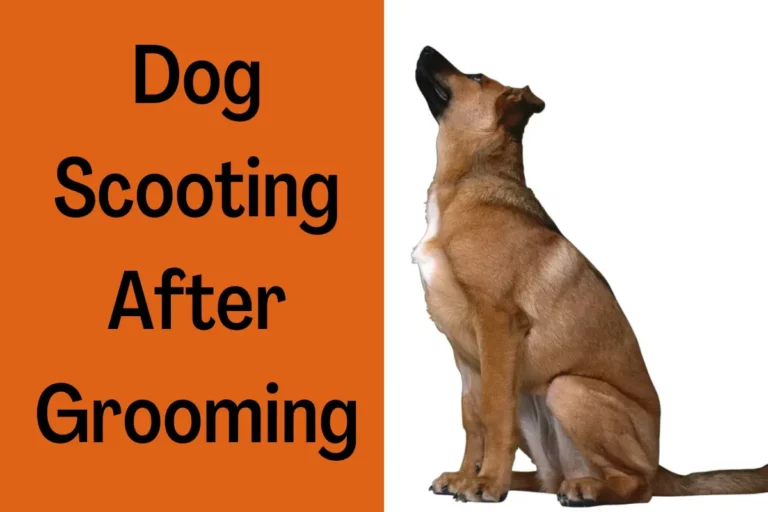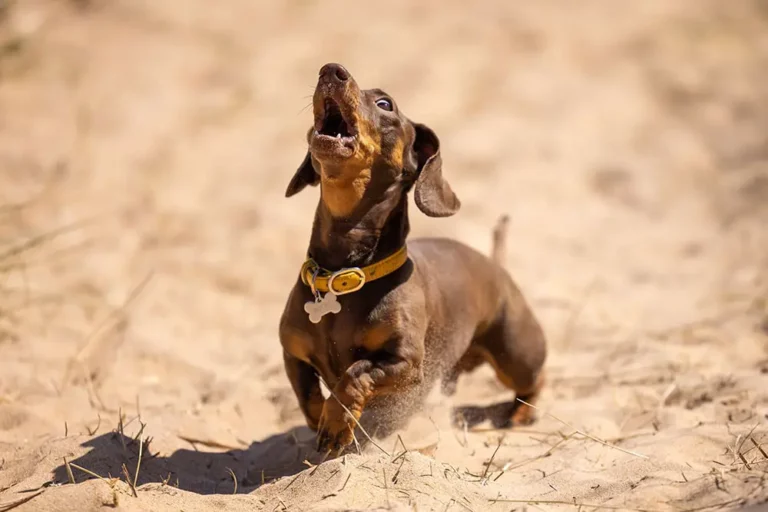Why Does My Dog Lay On My Neck? (12 Reasons Explained)
Sometimes your dog comes to you in your bed. You might think they want cuddles, snuggles or even play. But when your dog finally curls up on your neck, the question “why?” is often asked.
Dogs may lay on their owner’s neck for various reasons, such as seeking warmth and comfort, expressing affection and bonding, or sensing their owner’s emotional state. In some cases, this behavior may also be related to dominance, a need for attention, or underlying health issues.
By learning about the different factors that can influence why dogs lay on their owners’ neck, you can strengthen your bond and communication with your pet, ensuring a happy and healthy relationship.
So, let’s explore the key reasons why your dog might choose to lay on your neck and discover what you can do to manage or encourage this behavior, depending on the situation.
Key takeaway
Dogs laying on your neck often represents bonding and trust.
It could be a way for your dog to seek comfort and warmth.
This behavior might be a result of your dog’s protective instincts.
It can also signify your dog’s dependency on you.
If your dog’s behavior becomes uncomfortable or problematic, training can help establish boundaries.
Why Does My Dog Lay On My Neck?
You might get confused when the dog starts laying on their neck. This behavior is not necessarily negative, and there are at least 12 reasons for this behavior. Read on to understand why you dog tries laying on (or around) your neck.

1. Safety and Security
One of the primary reasons dogs lay on their owner’s neck is because they are seeking safety and security. This behavior is deeply rooted in their natural pack instincts. In the wild, dogs would huddle close to their pack leaders for protection and reassurance, especially during times of vulnerability or danger.
As a dog owner, you play a similar role to the pack leader in your pet’s life. Your dog may view you as a source of comfort, protection, and guidance, which can explain why they lay on your neck.
They may feel more secure and safe when they are physically close to you. This behavior is also a sign that your dog trusts you and sees you as their protector.
It’s essential to recognize and respect your dog’s need for safety and security. You can provide them with a comfortable and safe environment by offering a designated sleeping area with soft bedding, ensuring they have a consistent daily routine, and spending quality time bonding with them.
By doing so, you will reinforce their sense of security and strengthen your bond as a pack leader.
2. Warmth and Body Temperature
Dogs are known to seek warmth and comfort, especially during colder weather or when they are feeling chilly. Your neck is an excellent source of heat, as it is a part of your body that naturally radiates warmth. By laying on your neck, your dog can benefit from your body temperature and stay cozy and comfortable.
If you notice that your dog tends to lay on your neck more frequently during colder months or in colder environments, it might be time to consider alternative ways to keep them warm.
Providing them with a heated dog bed, a cozy blanket, or even a sweater designed for dogs can help ensure they stay comfortable without relying solely on your body heat.
It’s also essential to monitor your dog’s overall comfort and health when it comes to temperature regulation. If your pet appears to be consistently cold, despite your efforts to keep them warm, it might be a good idea to consult your veterinarian for advice.
They can help you identify any underlying health issues or suggest additional ways to keep your furry friend warm and comfortable.
Table could not be displayed.3. Your Dog Is Hungry
Dogs don’t always bark for food; they often bark loudly for reasons that may seem nonsensical. However, when a dog needs something from you, it typically won’t bark. This type of barking is reserved for other dogs and unwelcome guests.
If your dog is hungry at night and needs food, you are the one who can address this issue.
Your dog will approach you and lay its head on your neck to demonstrate its vulnerability and neediness. This is an indication that your dog requires nourishment, and you should promptly provide some food.
4. Dog Is Stressed
Stress can be incredibly challenging for humans, and dogs are no exception. These lovable companions deeply care for you and thrive on routine. When there’s a change in their environment or something new occurs, your dog may experience stress.
This stress can affect their behavior during the day, leading them to seek comfort by laying on your neck at night.
When your dog attempts to sleep on your neck, it helps them cope with stress and feel more at ease. Similar to humans, stress can disrupt a dog’s sleep. However, in your presence, their stress levels are likely to decrease, allowing your dog to sleep more peacefully.
5. Your Dog Is Trying To Protect You
Dogs are herd animals who are generally led and protected by a pack leader. When your dog places its head on your neck, they do not only recognize you as a companion but also as a leader who can protect them from attack and danger.
So, it’s not necessarily a weird behavior because that’s part of their survival instinct.
6. Feeling Sick
Although less common, there could be underlying health issues contributing to your dog’s neck laying behavior.
If your pet suddenly starts laying on your neck more frequently or exhibits other concerning symptoms, such as lethargy, changes in appetite, or restlessness, it might be worth consulting with a veterinarian to rule out any potential health problems.
Certain medical conditions, such as joint pain, anxiety, or discomfort caused by allergies, can lead your dog to seek additional comfort and support by laying on your neck. By addressing these health issues, you can help alleviate your dog’s discomfort and potentially reduce their neck laying behavior.
If a health issue is suspected, it’s crucial to consult with a veterinarian as soon as possible. They can assess your dog’s overall health, recommend appropriate treatments, and provide guidance on how to manage any ongoing health concerns.
7. Your Dog Is Insecure
There could be many reasons for the insecurity; if there is a change in the environment and the dog is affected by it directly, this will make your pup insecure. Some dog breeds are also likely to have feel more insecure than others.
This situation will make the dog come to you and stay by your side all day long and sometimes, snuggle on your neck. When a dog lays on your neck, it is possible that your dog lacks confidence and wants to do away with his feeling of insecurity.
8. Separation Anxiety
The second last and the most painful reason for this behavior for the dog and the owner is separation anxiety. If you have changed your routine and spend more time out than before, it will make your dog suffer from separation anxiety.
When you move your home or come back to him after a long period of absence, the dog will suffer from separation anxiety. Cuddling up to your neck helps the dog get some comfort.
Table could not be displayed.9. Affection and Bonding

Another reason your dog might lay on your neck is to express their love and affection for you. This close physical contact allows them to feel connected and nurtures the bond between you and your pet.
Dogs have different ways of showing affection, and laying on your neck can be one of their unique ways of demonstrating their love.
When your dog is cuddling or laying on your neck, they are likely seeking comfort and connection. By allowing this behavior, you are reinforcing your bond and creating a positive experience for your pet.
Additionally, responding with affection and gentle petting can encourage this behavior further, as your dog learns that laying on your neck results in positive attention and rewards.
Your dog relishes your companionship, and experts say their hormonal system releases the same hormones that a person in love experiences when in the presence of their beloved. Your dog desires to be as close to you as possible and snuggling on your neck is the perfect way to demonstrate this affection.
While it’s important to reinforce positive behaviors, make sure to balance this with setting appropriate boundaries.
If your dog’s habit of laying on your neck becomes too intrusive or problematic, consider providing them with other opportunities for physical contact, such as cuddling on the couch or hugging during designated playtime.
This way, you can maintain a strong bond without compromising your personal space or comfort.
10. Dominance and Asserting Control
In some cases, dogs may lay on their owner’s neck as a way to assert dominance or control. While this is less common than the reasons mentioned above, it’s essential to be aware of this possibility, especially if your dog is exhibiting other signs of dominant behavior.
The dominance hierarchy is a natural part of dog socialization, and your pet might be trying to establish their position within your household.
By laying on your neck, your dog may be attempting to communicate that they are in control or trying to exert their influence over you.
If you believe that dominance is the primary reason for your dog’s neck laying behavior, it’s crucial to establish clear boundaries and proper training to manage this issue.
Ensure that your dog understands their place in your household by consistently reinforcing your role as the pack leader. You can achieve this through obedience training, maintaining a consistent routine, and providing clear communication about acceptable and unacceptable behaviors.
Remember, it’s essential to address dominance-related issues with patience, consistency, and positive reinforcement. Resorting to harsh punishment or aggressive behavior can harm the bond between you and your dog and potentially exacerbate the problem.
11. Seeking Attention and Playtime
Sometimes, dogs lay on their owner’s neck simply because they crave attention and want to engage in playtime or activities. This behavior can be a clear signal that your pet is feeling bored, restless, or in need of stimulation. Dogs, just like humans, need mental and physical engagement to stay happy and healthy.
If you notice that your dog is laying on your neck more frequently when they have excess energy or haven’t had enough playtime, it’s essential to address their needs. By providing opportunities for physical exercise and mental stimulation, you can help prevent boredom and maintain a healthy, balanced lifestyle for your pet.
Consider incorporating regular walks, games of fetch, or play sessions with other dogs into your daily routine. Additionally, you can offer puzzle toys, interactive toys, or training exercises to engage your dog’s mind and help them expend any pent-up energy.
By meeting your dog’s needs for stimulation and exercise, you can reduce their reliance on neck laying as a means of seeking attention and maintain a happier, healthier relationship with your pet.
No products found.
12. Sensing Emotional States
Dogs possess an incredible ability to sense their owner’s emotional states, often picking up on subtle cues that indicate when you’re feeling stressed, anxious, or upset. If your dog lays on your neck, they may be trying to comfort you during times of emotional distress or provide a sense of security and support.
This empathetic behavior is yet another reason why your dog might choose to lay on your neck. By being close to you, they aim to offer emotional support and help alleviate any negative feelings you may be experiencing.
Many dog owners find this behavior endearing, as it demonstrates the deep connection and understanding between them and their pets.
If your dog’s neck laying behavior coincides with moments of emotional distress, take it as an opportunity to strengthen your bond and find comfort in their companionship.
You can also provide positive reinforcement for this behavior by rewarding your dog with praise, gentle petting, or even a small treat, acknowledging their efforts to comfort and support you during tough times.
What is my dog thinking?
When your dog lays on your neck, they likely see you as a comfort source. This behavior could reflect their feeling of safety, their protective instinct, or their need for your attention. Although it’s an indication of their trust and affection, it’s essential to set boundaries if it becomes uncomfortable.
Should I allow my dog to lie on my neck?
Well, this is all dependent on you. Most people love to have an intimate relationship with their dogs, and spending time with their buddies is the most joyful experience. These people love to snuggle with their best friends and usually go to sleep together.
If you belong to this category, you won’t mind your dog coming to you every night and lying on your neck. This will strengthen your bond and make your dog more inclined towards you. But that doesn’t mean things cannot be good the other way around when you don’t allow your dog to lay on your neck.
You can have a great relationship with your dog even if you don’t allow the pooch to lie on your neck. You can make them stop when they do it for the first time by gently pushing them away. The dog will get the cue, and there is a high chance he will not repeat the behavior.
When you don’t allow your dog to lay on your neck, you must look for why the dog wanted to stay by your side. If it is temperature, hunger, or fear, take corrective measures accordingly.
Also Read: Why Does My Dog Lay On Me When I’m On My Period?
Why does my dog bury his head in my neck?
Dogs have scents on their faces, and when they rub their face on your neck, this is a sign of protection and marking. The dog marks your body to leave their scent to tell other dogs that you are already taken and under their protection.
A dog puts his or her scent on your body to keep you in the loop and the shelter of the herd. It doesn’t matter if you are single and living only with the dog. Your best buddy will do it to make you the most important person in his life.
How can I discourage my dog from laying on my neck?
To discourage your dog from laying on your neck, try redirecting their behavior to a more appropriate form of physical contact or comfort. Offer them a comfortable bed or blanket to lay on instead and provide praise or a small treat when they choose to use it.
Consistency and positive reinforcement are essential when trying to modify your dog’s behavior. If needed, consider implementing obedience training to establish boundaries and teach your dog alternative ways to seek comfort and closeness.
How to stop my dog from laying on my neck?
We have mentioned various reasons why your dog lays on your neck, and we know it’s by no means harmful. But if you find this behavior uninteresting or uncomfortable, you can take corrective measures. But first, you need to understand the dog’s psychology.
You need to understand that if your dog always seeks to cuddle up to your neck, it’s most likely that you have given your canine a go-ahead in the past. Now you need to make consistent efforts to nip this habit in the bud.
When your dog comes near the bed, say no and get up from the bed. This act will make your dog understand that coming near the bed is a big no. You can make your dog stop snuggling you and laying on your neck every night with regular and consistent acts.
It’s also important to find out the reason for this behavior and provide them with their needs while enjoying a healthy relationship.
Moreover, dogs can injure the owner by snuggling and laying on the neck. If you are also the victim of this, you must remain strict in your tone and behavior and always prevent your dog from coming close enough to lay on you. This continuous denial helps kill such habit without hurting your relationship with your lovely pooch.
If things remain unchanged and your dog doesn’t withdraw from this behavior, it’s important to seek professional help. Consult your vet or animal behaviorist regarding this behavior, and you will learn about their specific needs.
Once all the canine needs are met, the good habits will eventually be molded.
Dog wraps around my neck
Just like humans hug each other, dogs also hug humans and wrap their front legs around the neck. If you have a larger dog fond of wrapping around your neck, you must ensure that the dog doesn’t choke you.
If you are comfortable with this, you don’t have to change anything. But if it brings you so much inconvenience, teach your dog then it’s time to set boundaries for your furry friend.
Also Read: Why Is My Dog Clingy When I’m On My Period? (6 Reasons)
Why does my dog lick my neck?
Dogs lick their owners’ necks for several reasons, some of which are as follows:
- Affection: Licking is a natural way for dogs to express affection towards their owners. When your dog licks your neck, it may be their way of showing love and appreciation.
- Taste: The salty taste of your skin might be appealing to your dog, and they could be licking your neck simply because they enjoy the taste.
- Comfort: Dogs may lick their owners to self-soothe or find comfort. When your dog licks your neck, it can be a calming experience for both you and your pet, as it releases endorphins and strengthens your bond.
- Grooming: Dogs instinctively groom themselves and each other, and licking is a part of this behavior. Your dog might lick your neck to “groom” you, which can be a sign of trust and closeness.
- Attention: Your dog might lick your neck to get your attention or to initiate playtime or other interactions.
It’s important to remember that every dog is different, and their reasons for licking your neck may vary based on their individual personality and experiences. If your dog’s licking becomes excessive or problematic, you may need to establish boundaries or consult a veterinarian or dog behaviorist for guidance.
Is it okay to let my dog sleep on my neck at night?
It’s generally okay to let your dog sleep on your neck at night if you’re comfortable with it and it doesn’t interfere with your sleep. However, consider your own comfort and personal boundaries, as well as your dog’s size and breed.
If you find it uncomfortable or if it disrupts your sleep, consider providing a designated sleeping area for your dog instead.
Can this behavior lead to aggression in my dog?
Neck-laying behavior is not typically associated with aggression. However, if the behavior stems from dominance or control issues, it could potentially escalate if not properly managed. In such cases, it’s essential to establish boundaries, reinforce your role as the pack leader, and use obedience training to ensure your dog understands appropriate behavior.
Are certain dog breeds more likely to exhibit this behavior?
While any dog can exhibit neck-laying behavior, breeds known for their strong bonds with their owners, such as Labrador Retrievers, Golden Retrievers, or Border Collies, may be more likely to seek physical closeness in this way. However, individual personalities and experiences can influence this behavior more than breed alone.
How do I establish boundaries without harming the bond between my dog and me?
Establishing boundaries is a crucial aspect of maintaining a healthy relationship with your dog. To do this without harming your bond, always use positive reinforcement and clear communication.
Teach your dog alternative ways to seek affection and closeness, and reinforce these behaviors with praise and rewards.
Consistency and patience are key when it comes to establishing boundaries, and by providing your dog with love, understanding, and guidance, you can maintain a strong bond while also setting limits on their behavior.
Final Thoughts
Understanding the reasons behind your dog’s neck-laying behavior can help you create a strong bond and provide the best possible care for your furry friend. Remember to consider your pet’s individual needs, establish healthy boundaries, and consult with a professional when needed.
By doing so, you can create a positive, nurturing environment for your dog and enjoy a happy, lasting relationship with your beloved pet.


![Poisoning in Dogs Symptoms [5 Signs Your Dog Has Poisoning]](https://www.warmlypet.com/wp-content/uploads/2022/12/poisoning-in-dogs-symptoms-768x512.webp)




